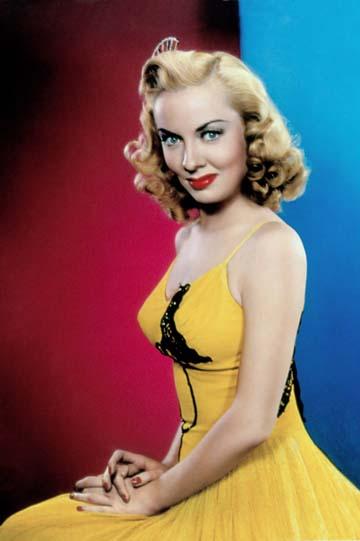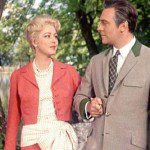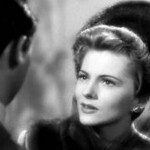Real Movie Stars: Fontaine, Parker and Totter
By • December 19, 2013 0 1458

There is a reason that Turner Movie Classics exists and remains popular and exists. It connects us to Hollywood’s past, to movie stars when they shone brightly, for a time. In old movies, old movie stars come alive. You recognize the faces, the voices and who you were when you first saw and heard them.
We are reminded of that every time a long-ago star or performer passes away, and we see them again in our minds as they were then — in the movies.
We lost three actresses this past week, each one singular and unique to a time, and in their fashion. Joan Fontaine was for a time Hollywood royalty across three decades, an Oscar winner, and part of a sibling rivalry that was remarkably enduring with her sister Olivia DeHavilland. Eleanor Parker was a red-headed beauty often used by the studios she worked for in relation to how she looked, which was always beautiful, but rarely for her talent, which was considerable. Audrey Totter was never quite the big star, but for a time she rose to prominence in the age of Hollywood noir films, those 1940s cops and robbers sagas almost always in black and white in which Philip Marlowe and Sam Spade types pursued murders and molls, often portrayed by Lauren Bacall, Mary Astor, Rhonda Fleming or Audrey Totter.
JOAN FONTAINE
Joan Fontaine and Olivia de Havilland were sisters, which seems to be the story that’s hung around Fontaine’s obituary—how the two English lasses came to Hollywood and thrived but seemed always to be in competition with one another.
Fontaine, who died at the age of 96 this past week, had a bit of a specialty when she finally broke through with a role in the 1930s version of “The Women,” which was to be a heroine who falls under the spell of magnetic, potentially dangerous men. At least that’s where her biggest success came—she won an Oscar playing one of Alfred Hitchcock’s first blonde beauties in “Suspicion,” in which she fears that her mysterious husband, played by Cary Grant with his usual suaveness and urbanity, with a touch of sharp menace. In “Rebecca,” a gothic, big old English house mystery-romance, she starred opposite Laurence Olivier (and was directed by Hitchcock again) and faced off with the sinister Judith Anderson. And, of course, there was the ultimate such role in “Jane Eyre,” in which she starred opposite Orson Welles.
Fontaine could do other things—she was very good in “Tender in the Night,” vied for the affections of Robert Taylor with Elizabeth Taylor in “Ivanhoe.” Mostly though, the rivalry with her sister is what’s grist for the Hollywood mill—they managed accidentally or on purpose to snub and embarrass each other on Oscar nights and barely spoke through the years. There was at this writing, no comment yet from Olivia de Havilland, who lives in France. She is 97.
ELEANOR PARKER
Eleanor Parker, who started to come to prominence in the 1940s, was a much better actress than anybody gave her credit for her. In terms of her beauty, she was made for Technicolor, and that’s what MGM in its infinite wisdom often used her for—as a kind of blazing-red adornment in such films as “Valley of the Kings,” “Scaramouche,” “Many Rivers to Cross,” “Escape from Fort Bravo,” “The Naked Jungle” and the like. It’s not that she gave bad performances—her high-spirited theater performer in the French Revolution in “Scaramouche” was a delight opposite Stewart Granger.
She starred in “Caged,” which got her noticed in what was to become a kind of sub-noir genre of women in prison movies and was outstanding as the wife of Kirk Douglas in “Detective Story,” a terrific cop drama of the early 1950s. She also played Frank Sinatra’s crippled wife in the tough-minded “The Man With the Golden Arm,” in which Sinatra played a drug addict.
But it seems her most enduring film is the role of the countess who lost out to Julie Andrews for the affections of Christopher Plummer in “The Sound of Music,” a fact that is today remembered very well, given the recent live television production of said “Sound”.
Eleanor Parker died December 9 in Palm Springs. She was married four times and had four children. She was 91.
AUDREY TOTTER
In the movies, Audrey Totter never quite gained the stature of, say, an Eleanor Parker or Joan Fontaine, but she had a long career in genre movies, most of them of the noir variety, and later, thrillers and mysteries and westerns, including television types. Hollywood always had roles for her, until it didn’t—or until westerns, thrillers and noir films simply faded away.
You can pretty much tell her career path from the titles and the roles beginning with a small part in “The Postman Always Rings Twice,” which made a big star out of Lana Turner. She was in the Philip Marlowe (Dick Powell) mystery “Lady in the Lake, in “High Wall,” in “The Unsuspected,” in “Alias Nick Beal,” in “Tension” and in “The Set Up.” Later during the 1950s, she had roles in “The Carpetbaggers” and “Harlow.”
You remember her in those movies if you saw them: she was the tough-talking, good-looking blonde who didn’t take much guff from gunsels, gunslingers or cops.
Audrey Totter died eight days before her 97th birthday. Unlike many a Hollywood player, the Joliet, Ill. native, was married for 42 years to Leo Fred, an assistant dean of the UCLA School of Medicine.
- Audrey Totter
- Jordan Wright




